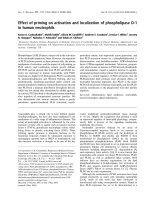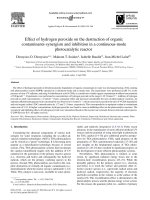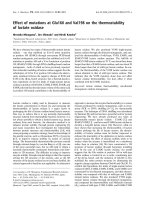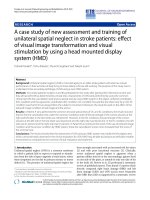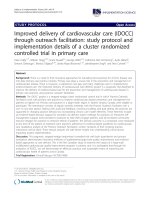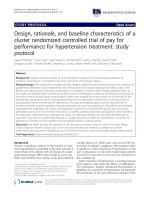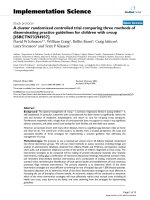Bronchodilatory effect of inhaled budesonide/ formoterol and budesonide/salbutamol in acute asthma: A double-blind, randomized controlled trial
Bạn đang xem bản rút gọn của tài liệu. Xem và tải ngay bản đầy đủ của tài liệu tại đây (426.13 KB, 7 trang )
Arun et al. BMC Pediatrics 2012, 12:21
/>
RESEARCH ARTICLE
Open Access
Bronchodilatory effect of inhaled budesonide/
formoterol and budesonide/salbutamol in acute
asthma: a double-blind, randomized controlled
trial
Jenish J Arun, Rakesh Lodha* and Sushil K Kabra
Abstract
Background: There are no published studies that have compared bronchodilatory effect of inhaled budesonide/
formoterol combination with budesonide/salbutamol delivered by metered dose inhaler with a spacer in acute
exacerbation of asthma in children. We, therefore, compared the bronchodilatory effects of inhaled budesonide/
formoterol (dose: 200 μg and 12 μg respectively) combination with budesonide (200 μg)/salbutamol (200 μg)
administered by metered dose inhaler and spacer in children of 5-15 years with mild acute exacerbation of asthma
[Modified Pulmonary Index Score (MPIS) between 6-8] in this double-blind, randomized controlled trial. The primary
outcome was FEV1 (% predicted) in the two groups at 1, 5, 15, 30, 60 min after administration of the study drug.
Results: We did not observe any significant differences in the % predicted FEV1 and MPIS between formoterol and
salbutamol at various time points from 1 min to 60 min post drug administration. There was significant
improvement in FEV1 (% predicted) from baseline in both the groups as early as 1 min after drug administration.
Conclusions: Salbutamol or formoterol delivered along with inhaled corticosteroid by metered dose inhaler with
spacer in children between 5-15 years of age with mild acute exacerbation of asthma had similar bronchodilatory
effects.
Trial Registration: ClinicalTrials.gov: NCT00900874
Keywords: Acute asthma, Bronchodilatation, Formoterol, Salbutamol
Background
Bronchial asthma is one of the commonest chronic
respiratory illnesses encountered in clinical practice in
both adults and children. Asthma therapeutics can be
broadly divided into long-term controllers and shortterm reliever medications. Among inhaled bronchodilators, short acting beta agonists (SABA) like salbutamol
and terbutaline are preferred in acute asthma exacerbations while inhaled corticosteroids (ICS) are the mainstay for long term treatment of asthma [1]. In moderate
to severe persistent asthma, long acting beta agonists
(LABA) like salmeterol and formoterol are added to ICS
* Correspondence:
Department of Pediatrics, All India Institute of Medical Sciences, New Delhi,
Ansari Nagar 110029, India
[1]. Efficacy and safety of LABA has been demonstrated
in both adult and young asthmatics [2].
It is desirable to have a single inhaled medication that
can be used as both reliever and controller; formoterol
is likely to be one such agent as it has both rapid onset
and long lasting action [3]. This will facilitate use of a
single formulation (ICS + Formoterol) in children with
persistent asthma. Few studies performed in adults with
acute asthma exacerbation have demonstrated that formoterol was as efficacious and well tolerated as salbutamol [4-6]. Rodrigo et al. identified nine randomized
controlled trials (576 patients; 3 trials included children)
comparing formoterol with SABAs in acute exacerbation
[4]; no significant difference was detected between formoterol and salbutamol in clinical and spirometric
parameters.
© 2012 Arun et al; licensee BioMed Central Ltd. This is an Open Access article distributed under the terms of the Creative Commons
Attribution License ( which permits unrestricted use, distribution, and reproduction in
any medium, provided the original work is properly cited.
Arun et al. BMC Pediatrics 2012, 12:21
/>
In a systematic review conducted to assess the efficacy
and safety of formoterol as reliever therapy in comparison to SABAs in adults and children with asthma, the
authors reported that formoterol was similar to SABAs
when used as a reliever, and showed a reduction in the
number of exacerbations requiring a course of oral corticosteroids in adults [5]. Formoterol may have an
advantage of longer duration of action as compared to
SABAs. However, for children with asthma, there was
insufficient information reported in the included trials
to arrive at any conclusion on the safety or efficacy of
formoterol as reliever [5].
There are few studies in children [6,7] which have
compared formoterol and salbutamol delivered by different routes like nebulisation or dry powder inhalation in
acute exacerbation. These studies concluded that both
the drugs were equally efficacious in acute exacerbation.
Bussamra et al. [8] compared terbutaline and formoterol
delivered by dry powder inhaler performed in children
with mild to moderate acute exacerbation of asthma;
both treatments resulted in similar clinical and functional improvement without any adverse effects. LABA
(including formoterol) montherapy is not indicated in
patients with asthma and the LABAs should only be
used in combination with ICS for moderate and severe
persistent asthma patients who cannot be well controlled with ICS and SABA treatments.
There are no published studies that have compared
budesonide/formoterol with budesonide/salbutamol
delivered by metered dose inhaler with a spacer in acute
exacerbation of asthma in children.
The objective of this study was to compare bronchodilatory effect of inhaled budesonide/formoterol (dose: 200
μg and 12 μg respectively) combination with budesonide
(200 μg)/salbutamol (200 μg) administered by metered
dose inhalers and spacer in children of 5-15 years with
mild acute exacerbation of asthma; the evaluation were
done only over a period of one hour after administration
of medications.
Methods
Patients
Children of either sex between ages of 5-15 years with
mild acute exacerbation of asthma were enrolled after
obtaining written informed consent from the parents.
Children with acute life threatening asthma, chronic
respiratory illness and those who took salbutamol 6 h
prior or those getting long acting b 2 agonists were
excluded.
Study design
This double blind, randomized controlled trial was carried out in Pediatric out patient and Pediatric Chest
Clinic (PCC) of a tertiary care hospital in north India.
Page 2 of 7
Randomization was done using computer-generated
sequences by a scientist not involved in the conduct of
this trial. Allocation was concealed with the use of
sealed, opaque envelopes.
Study drugs
We used Formoterol & budesonide combination MDI (6
μg of formoterol + 100 μg of budesonide per actuation)
and placebo MDI in one group and salbutamol MDI
(100 μg per actuation) and budesonide MDI (100 μg per
actuation) in the other group. Lupin Limited (formoterol
+ budesonide combination MDI and placebo MDI) and
Cipla Limited (salbutamol MDI and Budesonide MDI)
supplied the MDIs. These pharmaceutical companies
did not have any role in the trial except providing medications. For blinding, similar looking metered dose inhalers (MDIs) were labeled in pairs: A1, A2; B1, B2; C1,
C2; D1, D2; E1, E2; F1, F2. As per random numbers
patients were given drugs from these MDIs. The study
staff as well as the subjects were blinded to the interventions as the canisters were similar in appearance and
size; the original labels were removed from all of the
canisters.
Intervention
Children were administered 2 actuations of each MDI to
receive either formoterol (12 μg) or salbutamol (200 μg)
with a spacer; both groups received 200 μg budesonide.
Participants were explained about the study, spirometry
and inhalation of medicines with metered dose inhaler
and spacer.
Assessment
Mild acute exacerbation was defined as children presenting with increase in symptoms (cough, wheeze,
breathlessness) for less than 7 days duration, no chest
indrawing, and no difficulty in speech with Modified
Pulmonary Index Score (MPIS) between 6-8 [9]. MPIS
was calculated by the physician after observing the child
for the following aparmeters: SpO2 at room air, use of
accessory muscles, inhalational: exhalation ratio; wheezing; Heart rate and respiratory rate [9]. This evaluation
could be completed within a minute. A baseline spirometry was done using portable spirometer (Superspiro
MK2 Micro Medical Ltd, UK). FVC, PEFR, FEV1, FEF50
were recorded. Spirometry was repeated at 1, 5, 15, 30,
and 60 min after administration of study drug. The
patient was asked to perform spirometry thrice each
time and the best of the effort was recorded. Similarly
MPIS was calculated at these time points. In addition,
data regarding any adverse effects like tremors, nausea,
vomiting were recorded. Details of history and physical
examination including symptoms with their duration,
type of asthma, family history of allergy and medications
Arun et al. BMC Pediatrics 2012, 12:21
/>
were recorded in a structured performa; this was done
after the initial evaluation was done and the child administered the study medications. If the child did not
improve or showed worsening during study period, dose
of salbutamol was administered using a MDI.
The study protocol was approved was by the AIIMS
Institute Ethics Committee (Ref. No.: C/A-72/2.08.2008).
The research was carried out in compliance with the
Helsinki Declaration. The trial was registered at clinicaltrials.gov (ClinicalTrials.gov Identifier: NCT00900874).
Outcome measures
The primary outcome variable was FEV1 (% predicted)
in the two groups at 1, 5, 15, 30, 60 min after administration of the study drug.
Secondary outcome variables that were evaluated
included the difference in Modified Pulmonary Index
Score between the two groups, adverse effects like tremors, vomiting, palpitation, etc., number of patients
requiring hospitalization at end of study period, and
number of children who deteriorated during 1-h study
period.
Sample size
Sample size was calculated for equivalence. If there is
truly no difference between control (Salbutamol) and
experimental (Formoterol) groups, then 72 patients are
required to be 80% sure that the 95% confidence interval
will exclude a difference in mean FEV1 (% predicted) of
more than 10 [(assuming SD of 15, based on our
unpublished data and data from another study [8,10].
Statistical methods
Data were managed in Microsoft Excel spreadsheet and
analyzed by STATA software (StataCorp College Station, TX) before breaking the code. The baseline parameters between both the groups were compared. Mean
and standard deviation were used to summarize the
continuous variables. Inter-group and intra-group comparison of FEV1- percent predicted and Modified Pulmonary Index Score was done at 0, 1, 5, 15, 30 and 60
min. Chi-square test was used for comparing proportions and ‘t’ test for continuous variables. A p value of <
0.05 was considered significant.
Results
100 children of either sex, 5 to 15 years of age, with
acute mild exacerbation of asthma attending Pediatric
OPD or the Pediatric Chest Clinic were screened for
enrolment in the study between May 2009 and April
2010. 10 of them were not enrolled as they had taken
salbutamol or LABA prior to the screening. Ninety children were enrolled in the study and randomized to 2
groups- 45 to budesonide/salbutamol group (children
Page 3 of 7
received salbutamol and budesonide), and 45 to budesonide/formoterol group (children received formoterolbudesonide combination and placebo). Two patients in
salbutamol group could not complete the study (one
child could not perform spirometry and data were
incomplete in the other patient). Trial profile is shown
in Figure 1. No child failed to stabilize during the observation period.
The mean (SD) age of children in the budesonide/salbutamol group was 8.6 (2.3) years and 8.9 (2.1) years in
the budesonide/formoterol group. The mean (SD)
weight and height of children in budesonide/salbutamol
group were 23.3 (6.3) kg and 127.2 (14.2) cm, respectively whereas in budesonide/formoterol group it was 25
(8.2) kg and 129 (13.5) cm, respectively. Presenting complaints like cough, breathlessness, night symptoms, type
of asthma, frequency of exacerbation per year and family
history of allergy or asthma were comparable between
both the groups. The most common presenting symptoms were breathlessness, cough, night symptoms and
wheeze in both the groups (Table 1).
The type of asthma presenting with mild acute exacerbation in this study were predominantly intermittent or
mild persistent type in both the groups (Table 1). Only
one case of severe persistent asthma was enrolled in
budesonide/salbutamol group. Presence of family history
of allergy or asthma was present in 22 (49%) children in
budesonide/salbutamol group and 21 (47%) in the budesonide/formoterol group.
The mean (SD) baseline MPIS score were 7.3 (1.2)
and 7.2 (1.0) in the budesonide/salbutamol and budesonide/formoterol groups, respectively. The mean baseline
spirometric parameters were similar in both the groupsFEV1 (% predicted) in the budesonide/salbutamol group
Figure 1 Trial profile. ITT: Intention to treat.
Arun et al. BMC Pediatrics 2012, 12:21
/>
Page 4 of 7
Table 1 Baseline characteristics of the study subjects
Budesonide/Salbutam
ol group
(n = 45)
Budesonide/Formoterol group (n = 45)
8.6 ± 2.3
8.9 ± 2.13
Age, years
Sex- male/female, n
Weight, kg
Height, cm
33/12
30/15
23.3 ± 6.3
127.2 ± 14.2
25 ± 8.2
129 ± 13.5
Duration of symptoms, days
6.0 ± 3.6
6.1 ± 4.1
Cough
44 (98%)
44 (98%)
Breathlessness
45 (100%)
41 (91%)
Night symptoms
27 (60%)
33 (73%)
Wheeze
24 (53%)
23 (51%)
3 [2-6]
3 [2-6]
Frequency of exacerbations
per year [median(IQR)]
Type of asthma
1. Mild intermittent
19 (42%)
18 (40%)
2. Mild persistent
15 (33%)
15 (33%)
3. Moderate persistent
10 (22%)
12 (27%)
4. Severe persistent
1 (2%)
0 (0%)
FEV1 (% predicted)
PEFR (% predicted)
FVC (% predicted)
7.3 ± 1.2
58.2 ± 18.1; N = 43
7.2 ± 1.0
55.9 ± 14.8
55.5 ± 21.5; N = 43
61.5 ± 28.3; N = 43
58.6 ± 16.3
53.8 ± 20.8
FEF50 (% predicted)
65.9 ± 37.6; N = 43
70.6 ± 23.7
FEV1/FVC (% predicted)
84.9 ± 21.9; N = 43
91.4 ± 14.5
MPIS
MPIS: Modified Pulmonary Index Score; Values are Mean ± SD, unless indicated
at baseline was 58.2 (18.1)% while that of budesonide/
formoterol group was 55.9 (14.8)%.
On comparing the post intervention values of percent
predicted FEV1 between both the groups at 1, 5, 15, 30
and 60 min, there was no statistically significant difference at any of the time points and the difference
between both the groups were always less than 10 (p >
0.05) (Table 2, Figure 2). The mean (SD) absolute
change in FEV1 (% predicted) from baseline to 60 min
was 12.2 (13.2) in the budesonide/salbutamol group
while in the budesonide/Formoterol group, it was 8.3
(13.0) with a p value of 0.16.
Intragroup analysis showed significant improvement in
FEV1 (% predicted) (p < 0.0001) at 1, 5, 15, 30, 60 min
compared to baseline in both the groups. The percentage change in FEV 1 from baseline at different time
points were also similar (Table 3). Peak expiratory flow
rates (PEFR), percentage predicted PEFR (Table 4) and
forced expiratory flow-50 (FEF 50) and percentage predicted FEF50 of both the groups were similar at different
time points during the study. Table 5 shows the percent
change in PEFR from baseline at different time points.
There was no significant difference between salbutamol
and formoterol groups in other spirometric parameters
also.
The Modified Pulmonary Index Scores of both the
groups were similar at 1, 5, 15, 30 and 60 min of the
study (Table 6).
Table 2 FEV1 (percent predicted) in the two groups at different time points
Time
Budesonide/Salbutamol
group N = 43
Budesonide/Formoterol group N = 45
Baseline
58.2 ± 18.1
55.9 ± 14.8
1 min
64.9 ± 18.9
61.3 ± 14.7
5 min
66.6 ± 17.1
64.5 ± 18.2
0.58
15 min
30 min
68.5 ± 17.9
69.0 ± 18.2
62.4 ± 16.1
65.2 ± 17.9
0.09
0.33
60 min
70.5 ± 20.7
64.3 ± 16.4
0.12
Values are mean ± SD
P value
0.32
Arun et al. BMC Pediatrics 2012, 12:21
/>
Figure 2 % predicted FEV 1 at different time points in the 2
groups.
Only 3 of the total 90 children experienced tremors.
Two of them belonged to salbutamol group while one
was from formoterol group; this difference was not statistically significant. None of the children had vomiting
or palpitations. No child deteriorated during the study
period or required hospitalization.
Discussion
In this double blind, randomized controlled trial, we
compared the bronchodilatory action of budesonide/
formoterol and budesonide/salbutamol in mild acute
exacerbation of asthma. We observed that budesonide/
formoterol had rapid onset of bronchodilatory action
similar to that of budesonide/salbutamol in mild acute
exacerbation of asthma in children 5-15 years of age.
Both clinical and spirometric parameters at different
time points after the administration of the drugs from
1 to 60 min showed no statistically significant difference in both the groups. Children within both the
groups showed significant improvement in FEV1 as
Page 5 of 7
well as MPIS. There was no significant difference in
side effects.
Few studies in children which compared formoterol
with salbutamol or terbutaline delivered by different
routes like nebulisation or dry powder inhalation in
acute exacerbation also concluded that both the drugs
are equally efficacious in acute exacerbation [6-8].
There are no published studies that have compared
budesonide/formoterol with budesonide/salbutamol
delivered by metered dose inhaler with spacer in acute
exacerbation of asthma in children. Studies in adults
comparing rapid bronchodilator response of formoterol
and salbutamol suggested comparable results [11-13].
A recent study by Bussamra et al. compared formoterol (12 μg) delivered by aerolizer and terbutaline (0.5
mg) delivered by dry powder inhaler (Turbohaler) in
mild to moderate acute exacerbation in children and
reported similar rapid bronchodilator action [8]. In this
study, all children received up to three doses of medications at interval of 20 min till they achieved predefined
spirometric parameters. All participants received oral
steroids. They concluded that both drugs had similar
clinical and spirometric improvement, variations in
FEV1 of 19.5% and 15.3% were observed in the formoterol and terbutaline groups, respectively. Rodriguez et
al. compared formoterol and salbutamol in 50 children
aged 5 to 12 years with acute asthma exacerbations of
any severity. Children received either single dose of 25
μg formoterol fumarate by nebuliser or 3 doses of Salbutamol (Albuterol) every twenty minutes for one hour
by nebuliser. Symptoms score, oxygen saturation and
lung function testing recorded before and one hour
after commencing treatment showed significant
improvement [7]. The results of our study are in concordance with these studies even though we enrolled
children with mild exacerbations and used single dose
of either medication delivered by MDI and spacer.
The results of our study and other studies suggest that
formoterol has rapid bronchodilator action similar to
salbutamol or terbutaline and possibly can be used as
rescue drug for acute exacerbations in children. We had
earlier compared bronchodilator action of two long acting beta agonists (formoterol and salmeterol) at 60 min
Table 3 Percentage change in FEV1 from baseline at different time points
Time
Budesonide/Salbutamol
group N = 43
Budesonide/Formoterol group N = 45
P value
1 min
11.4 ± 26.8
12.9 ± 25.0
0.77
5 min
16.8 ± 28.5
19.4 ± 33.4
0.70
15 min
30 min
20.0 ± 31.6
22.1 ± 35.9
16.7 ± 30.3
20.8 ± 35.1
0.60
0.86
60 min
23.7 ± 34.3
19.3 ± 31.1
0.52
Values are mean ± SD
Arun et al. BMC Pediatrics 2012, 12:21
/>
Page 6 of 7
Table 4 PEFR (percent predicted) in the two groups at different time points
Time
Budesonide/Salbutamol
group N = 43
Budesonide/Formoterol group N = 45
Baseline
58.5 ± 21.5
58.6 ± 16.3
1 min
5 min
63.4 ± 25.8
67.4 ± 25.6
59.8 ± 16.9
63.9 ± 14.2
P
value
0.43
0.42
15 min
67.2 ± 24.7
64.9 ± 16.7
0.60
30 min
68.6 ± 21.8
65.6 ± 14.8
0.46
60 min
70.2 ± 22.5
64.8 ± 15.8
0.19
Values are mean ± SD
in a randomized controlled trial and observed similar
improvement in FEV1 [14]. In this study, no comparisons were done in first 10 min of administration of the
drugs. International guidelines recommend against
monotherapy with LABA in the management of asthma
[15].
However, there are few concerns regarding long-term,
frequent use of LABAs. The extent of tolerance to badrenoceptor agonists is dependent on the dose and
duration of treatment. A randomized, double-blind, placebo-controlled, crossover trial in adults by Haney and
Hancox [16] assessed tolerance to the bronchodilator
action of salbutamol during ongoing treatment with
long-acting beta-agonist. They concluded that the
bronchodilator response to salbutamol was significantly
reduced in patients taking formoterol. Clinically relevant
tolerance to rescue beta-agonist treatment may occur in
patients treated with long-acting beta-agonists. Therefore, it is important to document that repeated doses of
formoterol as rescue drugs will not affect response to
treatment in acute exacerbation of asthma.
A systematic review evaluated the effects of the combination of LABA and inhaled corticosteroids versus a
higher dose of inhaled corticosteroids on the risk of
asthma exacerbations [17]. The authors concluded that
combination of LABA and ICS was more effective in
reducing the risk of exacerbations requiring oral corticosteroids than a higher dose of ICS in adolescents and
adults; in children there was no significant reduction,
but rather a trend towards an increased risk of oral steroid-treated exacerbations and hospital admissions was
observed [17]. Hence, the issue of safety in children on
long term use is yet to be resolved.
The strength of our study was that it was a double
blind, randomized controlled trial with adequate sample
size. We enrolled children with mild acute exacerbation
of asthma. We used metered dose inhalers to deliver
single dose (two actuations of MDI for each drug) as
these devices are commonly used in the management of
asthma. Unlike previous studies, we used a combination
of ICS and formoterol. Clinical and spirometric parameters were monitored as early as 1-min post administration of the drug and frequent observations at 5, 15,
30 and 60 min were done.
There are few limitations of our study. As the study
was done in children with only mild acute exacerbation,
the results cannot be extrapolated to children with moderate to severe exacerbation. The evaluation were done
only for an hour after administration; the advantages of
formoterol + ICS versus salbutamol + ICS are more
likely to be seen with longer follow-up periods, such as
upto 3-12 h post-dosing.
Conclusions
Results of our study suggest that budesonide/formoterol
can be used as reliever using MDI and spacer in children with mild acute exacerbations of asthma. This
approach may avoid carrying two different MDIs
Table 5 Percentage change in PEFR from baseline at
different time points
Time
Budesonide/
Salbutamol
group N = 43
Budesonide/Formoterol group
N = 45
P
value
1 min
14.4 ± 30.9
7.8 ± 29.8
0.31
Table 6 Modified Pulmonary Index Score (MPIS) in the
two groups at different time points
Time
Salbutamol group N =
43
Formoterol group N =
45
P
value
5 min
25.9 ± 35.7
18.2 ± 36.8
0.31
Baseline
7.3 ± 1.2
7.2 ± 1.0
15
min
26.7 ± 43.7
21.0 ± 42.2
0.54
1 min
5.4 ± 1.6
5.4 ± 1.9
30
min
35.4 ± 54.9
21.3 ± 37.8
0.16
5 min
4.3 ± 1.5
4.6 ± 1.7
0.38
60
min
36.3 ± 50.8
19.7 ± 37.2
0.08
15 min
30 min
3.9 ± 1.6
3.6 ± 1.6
4.1 ± 1.8
3.5 ± 1.7
0.66
0.8
60 min
3.5 ± 1.6
3.6 ± 1.9
0.76
Values are mean ± SD
Values are mean ± SD
0.66
Arun et al. BMC Pediatrics 2012, 12:21
/>
(salbutamol and ICS with formoterol), which may
improve patient compliance. Formoterol should not be
used as monotherapy for management of asthma. Before
budesonide/formoterol is recommended routinely for
management of acute exacerbations, issues like tolerance, long-term safety on repeated frequent use and
cost effectiveness should be proven.
Acknowledgements
We are thankful to Lupin Limited, Mumbai, India and Cipla Limited, Mumbai,
India for supplying the MDIs for the study.
Authors’ contributions
JJA participated in study design, recruitment of patients and conduct of
study; she also drafted the manuscript. RL was involved in the study design,
conduct of study, analysis of data and drafting of manuscript. SKK
contributed to the study dsign, its conduct and drafting of manuscript. All
the authors read and approved the final manuscript.
Competing interests
The authors declare that they have no competing interests.
Received: 10 March 2011 Accepted: 7 March 2012
Published: 7 March 2012
References
1. National Asthma Education and Prevention Program: Expert panel report
2. Guidelines for the diagnosis and management of asthma. Bethesda,
MD: National Institutes Of Health; 1991, Publication no.97-4051.
2. Jindal SK, Gupta D, Aggarwal AN, Agarwal R: Guidelines for management
of asthma at primary and secondary levels of health care in India- a
consensus statement developed under WHO- government of India
collaborative programme (2004-2005). Indian J Chest Dis Allied Sci 2005,
47:309-343.
3. Berger WE: The use of inhaled formoterol in the treatment of asthma.
Ann Allergy Asthma Immunol 2006, 97:24-33.
4. Rodrigo GJ, Neffen H, Colodenco FD, Castro-Rodriguez JA: Formoterol for
acute asthma in the emergency department: a systematic review with
meta-analysis. Ann Allergy Asthma Immunol 2010, 104:247-252.
5. Welsh EJ, Cates CJ: Formoterol versus short-acting beta-agonists as relief
medication for adults and children with asthma. Cochrane Database Syst
Rev 2010, 8(9):CD008418.
6. Avila-Castañón L, Casas-Becerra B, Del Río-Navarro BE, Velázquez-Armenta Y,
Sienra-Monge JJ: Formoterol vs. albuterol administered via Turbuhaler
system in the emergency treatment of acute asthma in children. Allergol
Immunopathol (Madr) 2004, 32:18-20.
7. Rodriguez E, Vera V, Perez-Puigbo A, Capriles-Hulett A, Ferro S, Manrique J,
Abate J: Equivalence of a single saline nebulised dose of formoterol
powder vs three doses of nebulised Albuterol every twenty minutes in
acute asthma in children: a suitable cost effective approach for
developing nations. Allergol Immunopathol (Madr) 2008, 36:196-200.
8. Bussamra MH, Stelmach R, Rodrigues JC, Cukier A: A randomized,
comparative study of formoterol and terbutaline dry powder inhalers in
the treatment of mild to moderate asthma exacerbations in the
pediatric acute care setting. Ann Allergy Asthma Immunol 2009,
103:248-253.
9. Carroll CL, Sekaran AK, Lerer TJ, et al: A modified pulmonary index score
with predictive value for pediatric asthma exacerbations. Ann Allergy
Asthma Immunol 2005, 94:355-359.
10. Sealed Envelope Ltd. Power (sample size) calculators. [http://www.
sealedenvelope.com/power.php].
11. Boonsawat W, Charoenratanakul S, Pothirat C, et al: Formoterol (OXIS)
Turbuhaler® as a rescue therapy compared with salbutamol pMDI plus
spacer in patients with acute severe asthma. Respir Med 2003,
97:1067-1074.
12. Najafizadeh K, Sohrab Pour H, Ghadyanee M, Shiehmorteza M, Jamali M,
Majdzadeh S: A randomised, double-blind, placebo-controlled study to
Page 7 of 7
13.
14.
15.
16.
17.
evaluate the role of formoterol in the management of acute asthma.
Emerg Med J 2007, 24:317-321.
Lee-Wong M, Chou V, Ogawa Y: Formoterol fumarate inhalation powder
vs albuterol nebulizer for the treatment of asthma in the acute care
setting. Ann Allergy Asthma Immunol 2008, 100:146-152.
Singhania N, Dhamija R, Lodha R, Kabra SK: Salmeterol vs. Formoterol: A
comparison of rapid bronchodilator effect in a randomized controlled
trial. Indian Pediatr 2008, 45:225-228.
Global Initiative for Asthma. Global Strategy for Asthma Management
and Prevention. 2008 [ />Haney S, Hancox RJ: Tolerance to bronchodilation during treatment with
long-acting beta-agonists, a randomised controlled trial. Respir Res 2005,
6:107.
Cates CJ, Lasserson TJ: Regular treatment with formoterol and an inhaled
corticosteroid versus regular treatment with salmeterol and an inhaled
corticosteroid for chronic asthma: serious adverse events. Cochrane
Database Syst Rev 2010, 1:CD007694.
Pre-publication history
The pre-publication history for this paper can be accessed here:
/>doi:10.1186/1471-2431-12-21
Cite this article as: Arun et al.: Bronchodilatory effect of inhaled
budesonide/formoterol and budesonide/salbutamol in acute asthma: a
double-blind, randomized controlled trial. BMC Pediatrics 2012 12:21.
Submit your next manuscript to BioMed Central
and take full advantage of:
• Convenient online submission
• Thorough peer review
• No space constraints or color figure charges
• Immediate publication on acceptance
• Inclusion in PubMed, CAS, Scopus and Google Scholar
• Research which is freely available for redistribution
Submit your manuscript at
www.biomedcentral.com/submit

